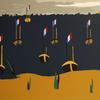Sharmin and Bijan Mossavar-Rahmani Fund New Gallery for Persian Art at Metropolitan Museum
- NEW YORK, New York
- /
- July 21, 2009
The Metropolitan Museum of Art announced today that a new gallery dedicated to Safavid and Later Persian Art (1500-1924) has been designated the Sharmin and Bijan Mossavar-Rahmani Gallery. It is one of a suite of exhibition spaces—the Galleries for the Arts of the Arab Lands, Turkey, Iran, Central Asia, and Later South Asia—that are overseen by the Museum's Department of Islamic Art and are scheduled to open in 2011. In addition to funding the gallery naming, Mr. and Mrs. Mossavar-Rahmani's significant grant will fund the publication of a catalogue on the entire collection of the Department of Islamic Art and an endowment to support educational programming on Iranian art – all part of the overall project of $50 million including capital and endowment.
"In announcing the naming of the new gallery, I am delighted to recognize the many years of generous and exemplary support of Bijan and Sharmin," commented Thomas P. Campbell, Director of the Metropolitan Museum. "The Museum's superb collection of Iranian art—one of the largest anywhere—is perhaps unrivalled in quality and scope in the western world, and we very much look forward to putting it back on view. Beautiful new galleries will serve as a perfect setting in which to present Persia's unparalleled aesthetic achievements, the deep interconnections between Iran and its neighboring cultures, and its influence stretching to Europe and China. We hope these galleries and the works of art they contain will foster a greater understanding among cultures, which is much needed in today's world."
Emily K. Rafferty, the Museum's President, continued: "Bijan and Sharmin's interest in the activities of the Museum—and especially those of the Department of Islamic Art—has taken on special meaning with this leadership gift to the Islamic gallery renovation initiative. In an encyclopedic museum such as the Met, it is our duty as well as our great pleasure to share art of the highest quality from all periods of time and all parts of the world with our global visitors. During this difficult time, we are particularly grateful to Bijan and Sharmin for their unwavering support of the Museum's mission."
The Sharmin and Bijan Mossavar-Rahmani Gallery will feature masterpieces created in Tabrîz and Isfahân under the imperial Safavid dynasty in the 16th and 17th centuries, and important works from the later 18th- and 19th-century Zand and Qâjâr periods. Among the highlights are the world-famous illustrations to the Book of Kings (Shâh-Nâmeh) that were painted by some of Iran's greatest artists and assembled for Shâh Tahmâsp between 1525 and 1535, and the magnificent Emperor's Carpet—one of the largest and most beautiful Persian carpets in the world—from the mid-16th century.
Active in industry and international affairs, Bijan Mossavar-Rahmani serves concurrently as Chairman of the Board of Directors of Foxtrot International, LDC, a Franco-American oil and gas company that operates in West Africa, and as CEO of Mondoil Enterprises, LLC, an energy holding company in the United States. He was the founder and President of Houston-based Apache International, Inc., and served as the Assistant Director for International Energy Studies at Harvard University's Energy and Environmental Policy Center. A former delegate to OPEC Ministerial Conferences, he is the author of numerous books and articles on global energy markets. He was educated at Princeton and Harvard universities, and serves on the Visiting Committee of the John F. Kennedy School of Government, of which he is an alumnus. He has been decorated a Commandeur de l'Ordre National de la Côte d'Ivoire, for services to the energy sector of that country. At the Metropolitan, he has served on the Visiting Committee for Islamic Art since 2003. In recognition of his active interest in the Museum, he was named to the Board of Trustees in January 2009.
Sharmin Mossavar-Rahmani, a Managing Director at Goldman Sachs, is the author of two books and numerous articles on portfolio management. She is a member of the Board of Trustees and the Investment Committee of New York-Presbyterian Hospital, and the National Advisory Board of the Merage Institute for the American Dream. She holds a baccalaureate from Princeton and a master's degree from Stanford University. Together with her husband, she has been a member of the Metropolitan Museum since 1985, and a member of the Museum's Friends of Islamic Art since 2000.
Through the initiative of the Noruz at the Met Committee, of which the Mossavar-Rahmanis are members, proceeds from two benefit celebrations of Noruz (Persian New Year) have raised more than $1.5 million to name an additional gallery—focusing on the medieval city of Nishapur in northeastern Iran—in honor of the Iranian-American community.
The Nishapur gallery, also opening in 2011, will contain materials that were excavated by the Iranian Expedition of The Metropolitan Museum of Art in several digs in the 1930s and 1940s. From architectural fragments that were found at the site, the Museum has reconstructed with accuracy the highly decorated walls of a small room from the 10th century.
# # #
July 10, 2009
1000 Fifth Avenue
New York, New York
About Metropolitan Museum of Art
The Metropolitan Museum of Art is one of the world's largest and finest art museums. Its collections include more than two million works of art spanning 5,000 years of world culture, from prehistory to the present and from every part of the globe. Founded in 1870, the Metropolitan Museum is located in New York City's Central Park along Fifth Avenue (from 80th to 84th Streets). Last year it was visited by 5.2 million people.





__2016_100x100_c.jpg)






![Peter Paul Rubens (Flemish, 1577–1640), After Titian (Tiziano Vecelli) (Italian [Venetian], c. 1488–1576), Rape of Europa, 1628–29. Oil on canvas, 71 7/8 x 79 3/8 in. Peter Paul Rubens (Flemish, 1577–1640), After Titian (Tiziano Vecelli) (Italian [Venetian], c. 1488–1576), Rape of Europa, 1628–29. Oil on canvas, 71 7/8 x 79 3/8 in.](/images/c/e2/2e/Jan20_Rape_of_Europa100x100_c.jpg)



